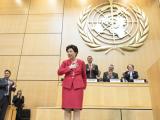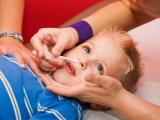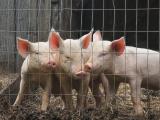Feb 22, 2010 (CIDRAP News) – At least 63 million Americans, 21% of the population, may have been infected by pandemic H1N1 influenza, Pittsburgh researchers estimate—creating enough population-wide immunity to potentially explain the lack of a third wave of H1N1 so far.
H1N1 infections clustered in young children and teenagers, in part because older adults retained some immunity from earlier infections—including the 2007 vaccine virus, the 1957 pandemic virus, and the 1918 "Spanish" flu—that may have partially protected them from the novel flu.
Writing in Public Library of Science Currents: Influenza, an online journal for sharing new research results that is not peer-reviewed, the researchers from the University of Pittsburgh say the joint effect of those old and newly acquired immunities will likely prevent further spread of H1N1 flu.
"High anti-2009 H1N1 seroprevalences among school children and high anti-1918 H1N1 seroprevalences among the elderly suggest that further sustained viral transmission is not likely," they write. "With current estimates of seroprevalence and continued increases in population due to vaccination, a significant change in viral antigens or a change in population immunity would be required for further disease spread.
"However, we cannot rule out the possibility that geographical pockets of limited immunity may be present in which a third wave may yet occur."
The researchers' estimate, based on analysis of blood samples collected in Pittsburgh toward the end of 2009, updates a December estimate by the Centers for Disease Control and Prevention (CDC) that approximately 50 million Americans had been infected by H1N1 flu. It is also effectively a companion piece to a serologic survey done in the United Kingdom and published ahead-of-print by The Lancet last month that found an infection rate of 21% in children younger than 5 and 42% for children aged 5 to 14.
The Pittsburgh study made use of unused, leftover blood samples collected at the University of Pittsburgh Medical Center's Presbyterian Hospital and the Children's Hospital of Pittsburgh in November and early December 2009, just after the pandemic's US peak. It also incorporated control samples that were collected in 2008, before the emergence of the novel H1N1 strain.
There were 846 samples from 2009, from patients whose ages ranged from 1 month to 90 years old but who were otherwise anonymous. The samples were analyzed for antibodies against the 2009 H1N1 strain, and also for evidence that the donors had been exposed to earlier H1N1 strains going as far back as 1918.
Overall, 21% of the 2009 samples showed evidence of pandemic H1N1 infection, but that differed widely by age-group, ranging from 29% among children younger than 9 and 46% among those aged 10 to 19, to 5% among seniors aged 70 to 79.
Extrapolating to the entire United States, the authors estimate that 63 million Americans, or 21% of the population, may have been infected with H1N1 by the time the second wave peaked.
About half of those in their 70s and 80s possessed antibodies to the 1957 and 1918 viral strains, a finding that the authors suggest may have given seniors some cross-reactive protection against the new strain. The authors point out that those findings support the long-standing hypothesis known as "original antigenic sin," which proposes that someone's first influenza infection leaves a lifelong impression via a strain-specific antibody response.
"The immunity afforded by the presence of 57% seroprevalence of antibodies against the 1918 H1N1 could explain the lower incidence of pandemic H1N1 infection seen among the elderly in the pandemic thus far," they write.
The analysis also supports the hypothesis that school-aged children are responsible for much of the spread of flu, the authors say. Though the breakdown is not given, the paper says that most of the positive antibody findings in the youngest age-group were among children 5 to 9 years old, and not among children younger than 5.
Ross T, Zimmer S, Burke D, et al. Seroprevalence following the second wave of pandemic 2009 H1N1 influenza. PLoS Curr Influenza 2010 Feb 20:PMC2820309 [Abstract]



















